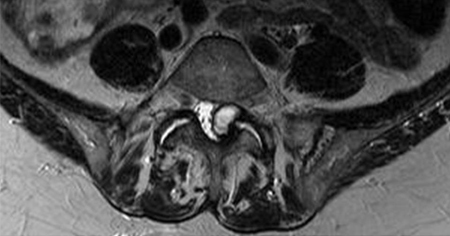შეჯამება
განსაზღვრება
ანამნეზი და გასინჯვა
ძირითადი დიაგნოსტიკური ფაქტორები
- წელის ქვედა ნაწილის პერსისტენტული ტკივილი
- ფეხის რადიკულური ტკივილი
- აქტივობასთან დაკავშირებული სიმპტომები
სხვა დიაგნოსტიკური ფაქტორები
- მოძრაობის შეზღუდვა წელის არეში
- გამართული ფეხის აწევის ტესტი
- ნევროლოგიური დეფიციტი (ფეხის სისუსტე, მგრძნობელობის დაკარგვა, შარდის ბუშტის და ნაწლავების სიმპტომები)
რისკფაქტორები
- ხანდაზმული ასაკი
- გენეტიკური გავლენა
- გარემო ფაქტორები (ჭარბი ღერძული დატვირთვა, ვიბრაცია ტრანსპორტირებისას)
- თამბაქოს მოხმარება
- ფასეტის სახსრის ტროპიზმი და ართრიტი
- მენჯის ანომალიური მორფოლოგია
- საგიტალური განლაგების ცვლილება
- სიმსუქნე
- შაქრიანი დიაბეტი
- ათეროსკლეროზი
დიაგნოსტიკური კვლევები
1-ად შესაკვეთი გამოკვლევები
- ხერხემლის ლუმბალური ნაწილის ვერტიკალური რენტგენოგრაფია
- ხერხემლის მრტ
გასათვალისწინებელი კვლევები
- ხერხემლის კტ
- ხერხემლის რენტგენი მოხრისას/გაშლისას
- ერთეული პოზიტრონულ-ემისიური ტომოგრაფია
- CT მიელოგრამით
- დისკოგრაფია
- თავის ტვინის მრტ გადოლინიუმის კონტრასტით
ახალი ტესტები
- გენეტიკური კვლევა
- ხერხემლის ფუნქციონალური კვლევა
მკურნალობის ალგორითმი
ნევროლოგიური გადაუდებელი მდგომრეობა (ნერვის ფესვის დეფიციტი ან ცხენის კუდის სინდრომი)
წელის მწვავე ტკივილი: <3 თვე საწყისი გამოვლინებიდან ან ქრონიკული ტკივილის გაუარესება
წელის ქრობიკული ტკივილი: ≥3 თვე საწყისი გამოვლინებიდან
კონტრიბუტორები
ავტორები
Jwalant S. Mehta, MBBS, MS(Orth), D(Orth), MCh(Orth), FRCS(Orth)
Consultant Spine Surgeon
Royal Orthopaedic Hospital
Birmingham
UK
გაფრთხილება:
JSM declares that he has received research support from Stryker K2M, Depuy Synthes and Nuvasive; is a speaker for AO Spine and Scoliosis Research Society; serves on the editorial board for the European Spine Journal, the Spine Deformity Journal, and the Bone Joint Journal, is a reviewer for the Global Spinal Journal, and is part of the Paediatric Spine Study Group.
მადლიერება
Dr Jwalant S. Mehta would like to gratefully acknowledge Dr Giannoulis Kyriakos and Dr Nasir Quiraishi, previous contributors to this topic. GK and NQ declare that they have no competing interests.
რეცენზენტები
Jayesh Trivedi, FRCS (Orth)
Consultant Spine Surgeon and Head of Department
Centre for Spinal Studies
Robert Jones and Agnes Hunt Hospital NHS Foundation Trust
Oswestry
Alder Hey University Children's Hospital
Liverpool
UK
გაფრთხილება:
JT declares that he has no competing interests.
John Ratliff, MD, FAANS, FACS
Associate Professor
Department of Neurosurgery
Stanford University
Stanford
CA
გაფრთხილება:
JR declares that he has no competing interests.
რეცენზენტების განცხადებები
BMJ Best Practice-ის თემების განახლება სხვადასხვა პერიოდულობით ხდება მტკიცებულებებისა და რეკომენდაციების განვითარების შესაბამისად. ქვემოთ ჩამოთვლილმა რეცენზენტებმა თემის არსებობის მანძილზე კონტენტს ერთხელ მაინც გადახედეს.
გაფრთხილება
რეცენზენტების აფილიაციები და გაფრთხილებები მოცემულია გადახედვის მომენტისთვის.
წყაროები
ძირითადი სტატიები
Kreiner DS, Hwang SW, Easa JE, et al. An evidence-based clinical guideline for the diagnosis and treatment of lumbar disc herniation with radiculopathy. Spine J. 2014 Jan;14(1):180-91. აბსტრაქტი
National Institute for Health and Care Excellence. Low back pain and sciatica in over 16s: assessment and management. Dec 2020 [internet publication].სრული ტექსტი
Expert Panel on Neurological Imaging, Hutchins TA, Peckham M, et al. ACR Appropriateness Criteria® Low Back Pain: 2021 Update. J Am Coll Radiol. 2021 Nov;18(11s):S361-S379.სრული ტექსტი აბსტრაქტი
გამოყენებული სტატიები
ამ თემაში მოხსენიებული წყაროების სრული სია ხელმისაწვდომია მომხმარებლებისთვის, რომლებსაც აქვთ წვდომა BMJ Best Practice-ის ყველა ნაწილზე.

დიფერენციული დიაგნოზები
- ხერხემლის სიმსივნე
- ხერხემლის ინფექცია
- პოზიციური წელის ტკივილი
მეტი დიფერენციული დიაგნოზებიგაიდლაინები
- CDC prescribing opioids for pain
- ACR appropriateness criteria: low back pain
მეტი გაიდლაინებიპაციენტის ბროშურები
Back pain (lower back)
Back pain: questions to ask your doctor
მეტი პაციენტის ბროშურებიშედით სისტემაში ან გამოიწერეთ BMJ Best Practice
ამ მასალის გამოყენება ექვემდებარება ჩვენს განცხადებას